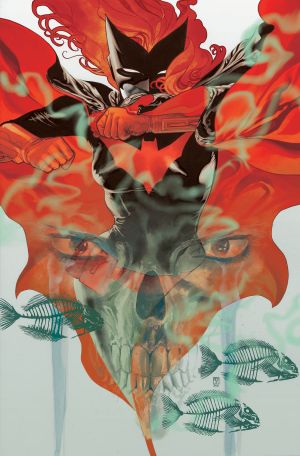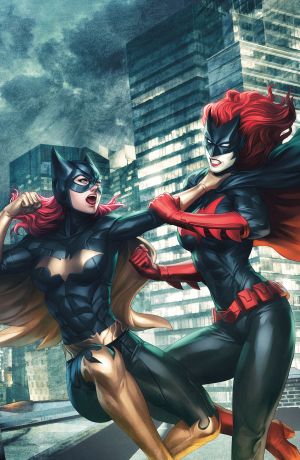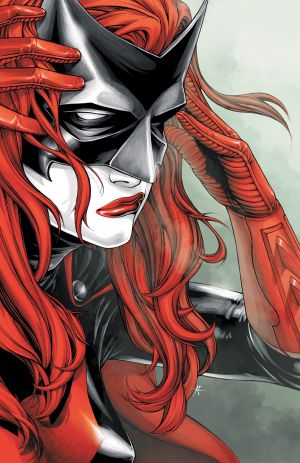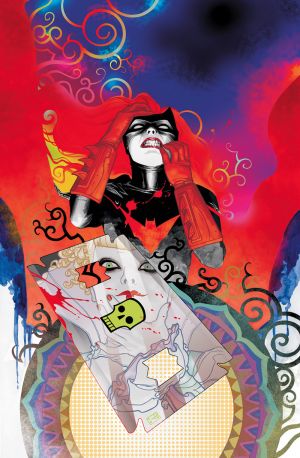Batwoman: Triple Threat
By J. Skyler
August 31, 2012 - 16:29
 |
When I heard the announcement in 2006 that DC Comics would be recreating Batwoman (who had been out of publication since 1985) as a lesbian, I scoffed at the idea. As a business student, one of my favorite subjects is marketing and I can usually see though an oversimplified gimmick quite easily. For all DC editorial talk of encouraging diversity, all I could see was a major corporation capitalizing on a modern day culture war by slapping a multibillion dollar trademark on a token character and passing itself off as a champion of progress. In the same way black woman across the country were mortified at the idea of a comedian like Tyler Perry adapting a landmark piece of black feminist literature like Ntozake Shange’s For Colored Girls Who Have Considered Suicide When the Rainbow Is Enuf (1975), I couldn’t fathom a group of heterosexual men having the frame of mind or sensitivity to write a Jewish lesbian with any depth. That’s not to say the idea is impossible (what is fiction for, if not to push yourself beyond the limitations of your own worldview?), but given the adversarial relationship between DC Comics and female characters, the plausibility of such a feat seemed unlikely. Nonetheless, I wanted to give Batwoman a chance, so when issue #7 of 52 came out, I picked it up as soon as I could.
 |
To my surprise, Greg Rucka and Grant Morrison were able to keep Batwoman at the forefront of DC Comics (albeit in small increments) through Countdown to Final Crisis and Final Crisis, as well as the mini-series Crime Bible: The Five Lessons of Blood. Still, there was only so much that could be done for her in terms of character development making appearances in supporting roles in company-wide crossovers and a single mini-series. Even DC editorial expressed dismay over the unnecessary news coverage and debate concerning her character, which caused understandable confusion on how to handle her properly. I assumed DC’s admission would have been the final nail in Batwoman’s coffin, considering the continued delay of launching her own monthly title which never seemed to surface. I was taken by surprise yet again when the company announced Batwoman would take Batman’s place as the star of Detective Comics. This change in line-up was a monumental risk from a business point of view. Taking a relatively new and controversial character and putting her in place of the second most iconic character in history—in their flagship title no less—was nothing short of astonishing. It was a display of commitment I though the company lacked, disproving the idea that they were only capable of broken promises. And then there was “Batwoman: Elegy”…
The inherit risk in publishing comic books is that a meaningful, well written story can be undermined by poor artwork, just as extraordinary visuals can give an a vapid piece of literature undue praise. At one point or another, every comic book reader, writer, editor and artist has said to themselves, “Wow, what a brilliant story! Too bad the art sucks,” or “Dear GOD, this art is stunning! Too bad it’s wasted on such a clichéd script.” Even when prolific writers and artists come together on a project, their respective talents don’t always complement one another. Notable creative teams who have achieved perfect synergy include Jeph Loeb and Michael Turner (Superman/Batman), Gail Simone and Ed Benes (Birds of Prey), Peter David and Todd Nauck (Young Justice), Scott Peterson/Kelley Puckett and Damion Scott (Batgirl), Geoff Johns and Ivan Reis (Aquaman) and finally Greg Rucka and J. H. Williams III (along with some brilliant coloring by Dave Stewart) in Detective Comics. “Batwoman: Elegy” is the kind of literary and artistic masterpiece a fictional character needs to become truly prolific. Although my personal preference in comic book art usually falls along the lines of Jim Lee and Michael Turner’s rigid penciling, William’s fluid artwork is completely enthralling, as if he invites the reader to walk through a lucid dream. Through unconventional sequential art, he and Rucka enable us see the woman behind the mask, and the layers which define her.
 |
Prior to the repeal of DADT in 2011, I discussed the topic at length with students at Mt. San Antonio College. I often lead classroom discourse on LGBT topics with members of the LAMBDA Student Association for students taking Human Sexuality, Psychology of Sexuality, Sociology, Psychology of Women and Journalism. At one point, a student who supported Gay Rights asked if it was asking too much too soon to repeal DADT. He was genuinely concerned the repeal would cause dissention within the ranks, resulting in hate crimes against LGBT service members (I fear I found a number of students shared). My response was that there will always be hostility in the face of change. I was certain hate-crimes associated with the repeal would be unavoidable, but the possibility of violence could not stop progress. I asked the class to recall the decision to overturn segregation laws in the landmark Supreme Court Case Brown v. Board of Education in 1954. Three years after the fact, Governor Orval Faubus of Arkansas ordered the state’s National Guard to block nine black students from entering Little Rock Central High School, swearing that "blood would run in the streets" if they entered. In response, President Eisenhower sent military personnel to the school, in addition to federalizing the state National Guard, effectively removing any authority from Governor Fabus. Take a moment to really absorb that: a mere fifty-five years ago, armed soldiers were utilized to prevent black and white children from receiving basic education in the same classroom. Those same combat trained soldiers were subsequently required to escort and protect the “Little Rock Nine” from harassment and possibly worse. As documented in Educational Psychology (2010), “[e]ven with their military escort, the ‘Little Rock Nine’ experienced frequent psychological and physical abuse. Without the military presence some white students intensified their assaults in an effort to drive them out of Central High.” The suffering the Little Rock Nine endured was horrific, but had the Supreme Court not stuck down segregation, had those students—those adolescent minors—not mustered the courage to face such unbelievable bigotry, what would the United States look like today?
 |
As a woman she would have likely been excluded from combat, or given no recognition for it if she had received assignment, as women are often barred from infantry. As Paula Broadwell wrote in The New York Times piece “Women at War”, “[t]he Defense Department’s most recent version of the ‘ground combat exclusion policy,’ established in 1994, states: ‘Service members are eligible to be assigned to all positions for which they are qualified, except that women shall be excluded from assignment to units below the brigade level whose primary mission is to engage in direct combat on the ground’.” In other words, even if Kane had not been discharged under DADT, her capability to serve would have been limited due to gender restriction. The silver lining in her dishonorable discharge is that it gave way for her to become a soldier in a more effective way than her service in the military ever could: unrestricted, unencumbered and entirely on her own terms. While women in the real world continue to fight for the right to be recognized exclusively as military officers, Katherine Kane’s transformation into Batwoman recreates her as a special ops tour de force, shattering the proverbial glass ceiling.
Of course, her metamorphosis could not have been accomplished without help, in part, from her father, Colonel Jacob Kane. Her relationship with her father is quite touching, because his love her in all aspects of her identity, is truly unconditional. When she chooses to tell her father about her discharge (and by extension, her sexuality), she does so in a nonchalant manor, simply stating that she couldn’t tell Colonel Reyes “what he needed to hear.” She never displays fear, but I could feel her uncertainty; that moment every LGBT child goes through when they stand at the edge of the abyss, uncertain if they are about to irrevocably destroy their relationship with their families. Jacob Kane commends his daughter for maintaining her integrity by telling the truth, and leaves it at that. Initially, I rolled my eyes, thinking “right, like it’s that easy.” I’ve met a number of LGBT youth who have been vilified and physically assaulted by their parents, especially by their fathers. Clouded by my own personal experience, and the more tragic experiences of others, I overlooked the fact that in some cases, it really is that simple. More importantly, it should be that simple. Jacob Kane represents the ideal parent, one who sees all at once a child’s need to define themselves and at the same time, become something more. He provides her with the tools and skills necessary to achieve her self-actualization, while helping her to keep focus on the moral guidelines that drove her to take up the mantle of the bat.
For all her strengths, Katherine Kane is not without her flaws. However, they are what give her character depth, without distracting from her virtues. She possesses a fiery temper and pronounced arrogance, which often compels her to leap into a situation with both arms swinging. Though ambitious, she is entirely autocratic, taking no one’s point of view into consideration other than her own. Her aggression and admitted self-centered nature are what keep her from forming close ties with Batman and the rest of his allies. It is also what keeps the people closest to her at arm’s length. However, in spite of her many missteps, she continues to “soldier on.”
 |
In the aftermath of her feature in Detective Comics, Katherine Kane triumphantly appears in her own monthly title Batwoman as part of DC Comics’ company-wide relaunch, The New 52. Assuming lead writing responsibilities, J.H. Williams III gives his artwork a literary voice beginning the first arch “Hydrology”, co-authored by W. Haden Blackman; the title itself analogous to Williams unique artistry. As a fan of all things paranormal, what I find most compelling about William’s and Blackman’s storytelling is their use of urban legends such as La Llorona “The Weeping Woman” and, in their later volumes, Bloody Mary. Their use of horror simultaneously humanizes these characters, drawing the reader into the tragedies which turned them into monsters. Secondly, Williams and Blackman showcase Batwoman’s naïveté, declining to officially join Batman’s ranks, citing “daddy issues” and problems with authority, only to agree to enlist with the Department of Extranormal Operations (DEO) under extortion (though one might infer the reason she submits herself to the DEO is to satisfy a lingering need to serve her country in an “official” capacity). Although a force to be reckoned with, her choices often place her in increasingly compromising positions that make for great drama. For future storylines, I believe a team-up between Batwoman and Batman against the Joker, Harley Quinn, Alice and the Mad Hatter (whom Alice claims she could not be of any use to) would be pure ecstasy. In addition, I would love to see Batwoman explore Kaballah—the esoteric method of Jewish mysticism, which would gel perfectly with the supernatural elements built into her characterization.
As a whole, Batwoman reintroduction into the DCU has been perfectly executed. The struggles and stigmas a woman of her background would face in the real world are realistically explored in a fictional realm, despite the influence of paranormal and supernatural elements. In the same way Barbara Gordon’s Batgirl defined Women’s Liberation in the late 1960s and 1970s, Katherine Kane’s Batwoman defines the civil rights movement of the era: LGBT Equality—freedom from discrimination, the freedom to serve, the freedom to marry, the freedom to raise families, and quite simply, the freedom to be honest with one’s self and others. As Greg Rucka states, “She's not a Barbara Gordon clone… Kate Kane is her own person. She's got a distinct personal tragedy, as is requisite to wear the mantel of the bat… I've said this before, and you'll see it early on—for everybody else, when they put on a Bat costume, it's a costume. For Kate, it's a uniform. That influences everything she does, and it tells you volumes about her.” Driven by personal tragedy, armed with military combat skills and a broad arsenal, and possessing an indomitable spirit that criminals and heroes alike can’t help but recognize, Batwoman is indeed a triple threat.
Follow me on Twitter @jskylerinc
Related Articles:
Review: Batwoman #18
Review: Batwoman #17
Review: Batwoman #16
Review: Batwoman #15
Review: Batwoman #14
Review: Batwoman #13
Review: Batwoman #12
Review: Batwoman #11
Review: Batwoman #10
Review: Batwoman #9
